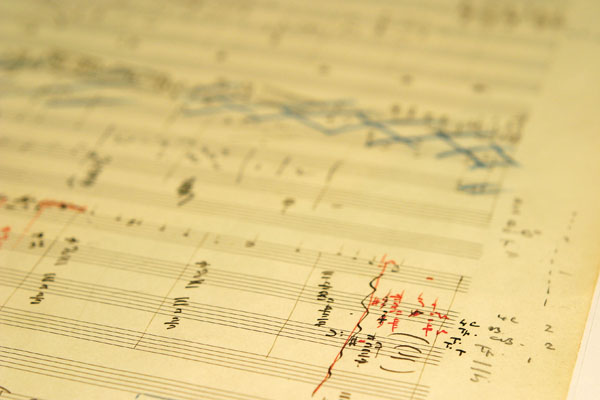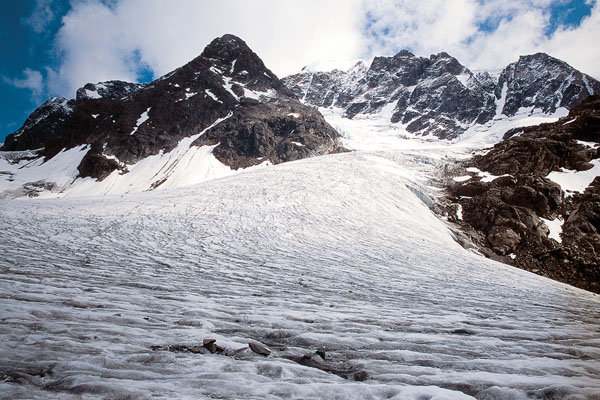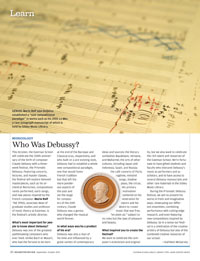Learn
 GENIUS: Marie Rolf says Debussy established a “new compositional paradigm” in works such as his 1905 La Mer, a rare autograph manuscript of which is held by Sibley Music Library. (Photo: Eastman School/Sibley Library)
GENIUS: Marie Rolf says Debussy established a “new compositional paradigm” in works such as his 1905 La Mer, a rare autograph manuscript of which is held by Sibley Music Library. (Photo: Eastman School/Sibley Library)This October, the Eastman School will celebrate the 150th anniversary of the birth of composer Claude Debussy with a three-week festival, the Prismatic Debussy. Featuring concerts, lectures, and master classes, the festival will explore beloved masterpieces, such as his orchestral Nocturnes, compositions rarely performed, early songs, and new pieces inspired by the French composer. Marie Rolf ’76E (PhD), associate dean of graduate studies and professor of music theory at Eastman, is the festival’s artistic director.
What’s most important for people to know about Debussy?
Debussy was one of the greatest pathbreaking composers who ever lived. Unlike Bach or Mozart, who had the fortune to be born at the end of the Baroque and Classical eras, respectively, and who built on a pre-existing style, Debussy had to establish a whole new compositional paradigm, one that would honor French tradition but that left the more ponderous aspects of the past and set the stage for composers of the 20th century. Claude Debussy was a genius who changed the musical world forever.
In what ways was he a product of his era?
Debussy was also a man of his time and influenced by a great variety of contemporary ideas and sources: the literary symbolists Baudelaire, Verlaine, and Mallarmé; the arts of other cultures, including Japan and Indonesia, Spain, and Russia; the café concerts of Paris; ragtime, minstrel songs, shadow plays, the circus. His primary motivation centered on his veneration for nature and his desire to create music that was free, “en plein air,” subject to no rules but the laws of pleasure and beauty.
What inspired you to create the festival?
We want to celebrate the composer’s eclecticism and originality, but we also want to celebrate the rich talent and resources of the Eastman School. We’re fortunate to have gifted students and faculty who interpret Debussy’s music as performers and as scholars, and to have access to several Debussy manuscripts and other rare materials in the Sibley Music Library. During the Prismatic Debussy festival, we aim to present his works in fresh and imaginative ways, showcasing our different ensembles, combining performance with cutting-edge research, and even featuring new compositions inspired by Debussy. So in a sense our festival is a celebration of the creative artistry of Debussy but also of the combined creative resources of our school.
—Kathleen McGarvey
 CORE KNOWLEDGE: Ancient ice holds clues for the modern climate. (Photo: iStockphoto)
CORE KNOWLEDGE: Ancient ice holds clues for the modern climate. (Photo: iStockphoto)Ice Man Arriveth
Vasilii Petrenko, assistant professor of earth and environmental sciences, is Rochester’s first climate scientist—though he says “paleoclimatologist” is a more accurate description. Petrenko works with ice core samples from Greenland and Antarctica to learn about the climate and environment thousands of years ago. Along with observations of contemporary conditions and computer modeling to predict future patterns, study of climatic history is essential to understand what is happening today, he says.
How far back does the ice record go?
In Greenland, we can go back a little over 100,000 years. In Antarctica, the oldest ice core has been dated to about 800,000 years. And we can probably go further back.
What can you learn from the ice samples?
One of the things I’m interested in is how the natural methane budget works. Methane is a very potent greenhouse gas, about 25 times more potent than carbon dioxide, and it has two types of sources today: one is natural, and one is anthropogenic—from humans. That source is now considerably larger than the natural sources, around a factor of 2 to 1. But there’s a lot of concern that with global warming, the natural methane budget might ramp up dramatically.
Does the melting ice in Greenland affect your research?
Some of the really large-volume samples that I need to get—some of my samples are a thousand kilograms, or about a ton—I can only get from the edges of the ice sheets because it’s impractical to get that much by drilling deep vertical cores.
But the edges are melting very fast, so the ice that’s available there is changing. In the Greenland Summit region, which is above 3,000 meters, it’s very cold year round—but in the last few years the instances where temperatures have gotten above freezing are increasing, and that creates melt layers in the snow and alters the way that gases are trapped.
We’re definitely feeling the influence. In my lifetime we’re not concerned about being able to retrieve the deep ice cores because the ice sheets do have a lot of inertia and it takes a long time to melt an ice sheet.
—Kathleen McGarvey
Do the Shoes Fit?
Judith Baumhauer ’09M (MPH), professor of orthopaedics, is president of the American Orthopaedic Foot and Ankle Society—the first woman to lead the organization. She was also the first female faculty member appointed to Rochester’s Department of Orthopaedics and Rehabilitation. A medical doctor specializing in orthopaedic foot and ankle surgery, she’s one of the nation’s few female professors in the field.
What don’t we know about our feet?
People assume they’re going to wear the same size shoe they wore in college, but actually they’re probably wearing a shoe that’s too small. Your foot continues to grow throughout your life—it’s called periosteal bone growth. More than 80 percent of women are wearing shoes too small for their feet.
Are foot problems seasonal?
In the winter, to get in shape people walk on the treadmill or use other machines. But those machines are a repetitive stress. Sometimes your body can take the repetitive stress and do OK. And sometimes just the action of taking the same step over and over and over again, hundreds of times, gives you an overuse injury. So you can get Achilles tendonitis, or posterior tibial tendonitis—the tendon that supports your arch. That tendon can be painful around the inside of your ankle.
Once it gets to be nice weather, people want to go outside to exercise. This avoids the treadmill but has other injury risks. Walking on uneven ground can make the ankle vulnerable to rolling, resulting in an ankle sprain. I still tell people I like them to walk or run outside because I like them to change up their terrain—it’s better for their balance and causes fewer overuse problems.
What do you say to people about high heels?
You want a shoe that’s supportive and fits well. Support is a function of shock absorption and arch support.
I wear high heels to functions, just like everybody else—but when I get to my table, I kick them off. They’re for show, not for use. High heels give you a look—your calf is a little tighter, your back is more arched, your shoulders are back a little bit, your posture is better. There are qualities about high heels that make people feel they look better. And there’s value in that—your self-esteem is important. But you have to recognize that it is a look—and they’re not the most functional thing.
—Kathleen McGarvey

